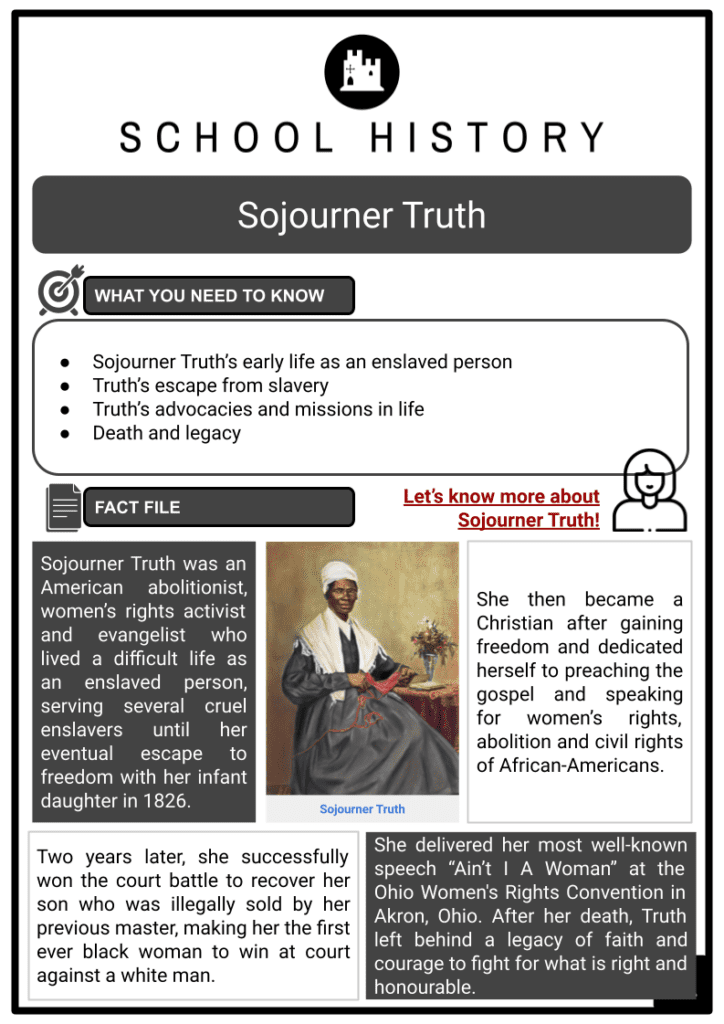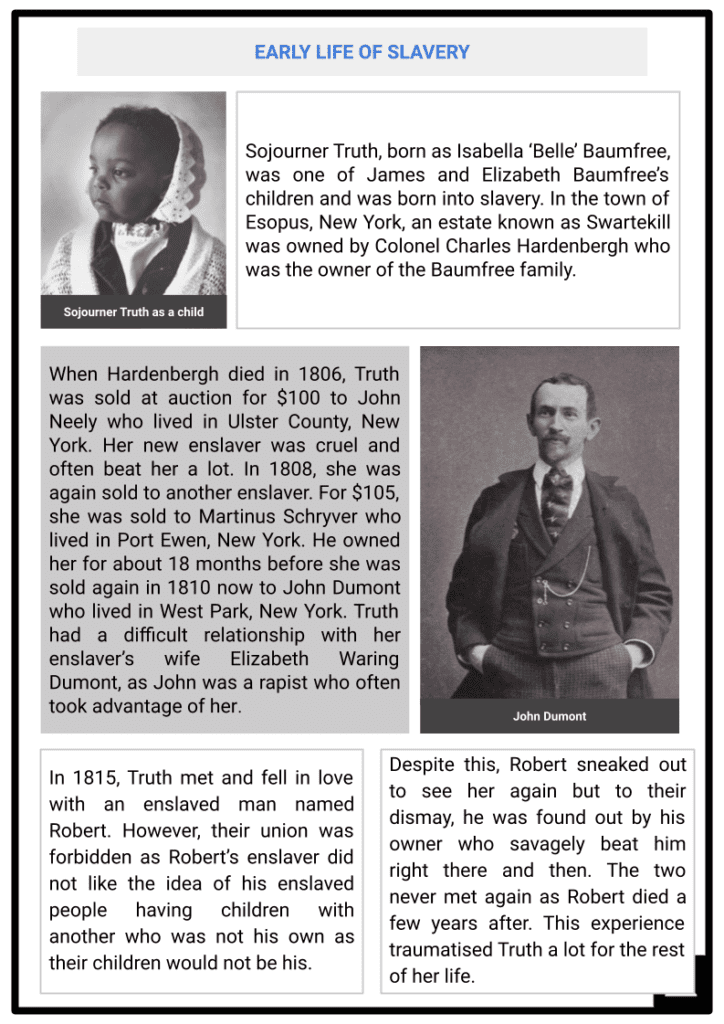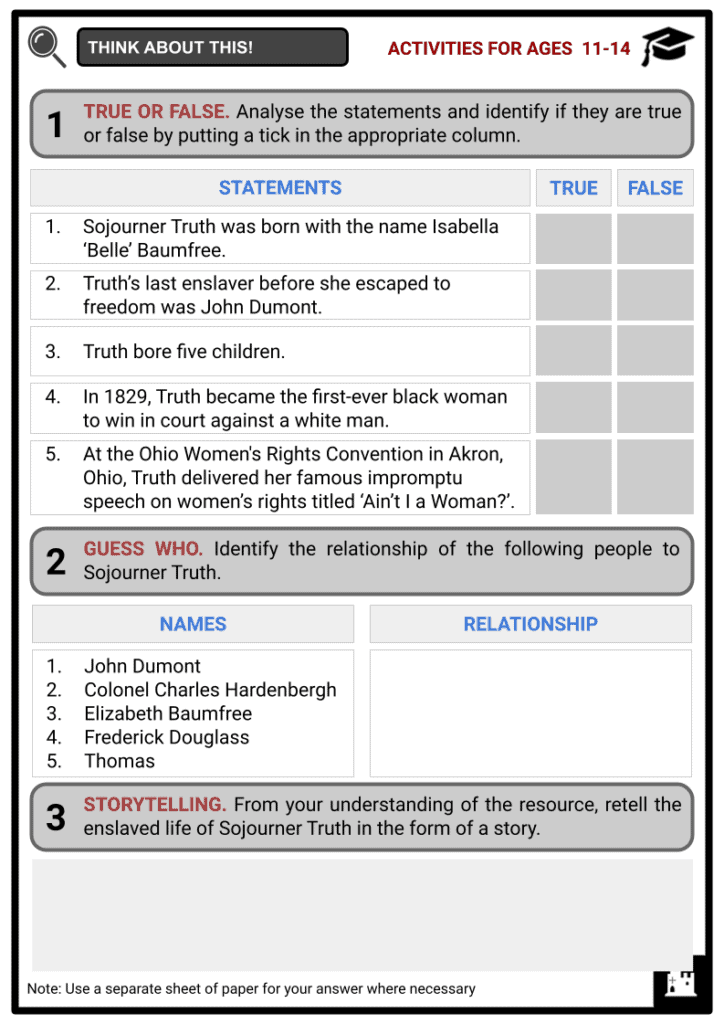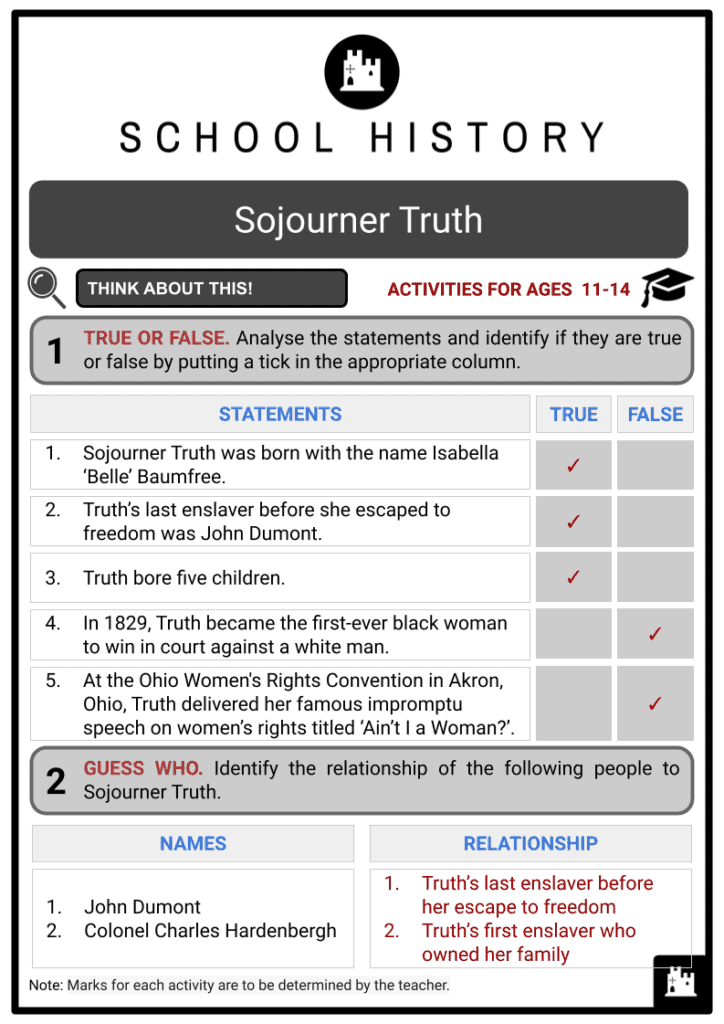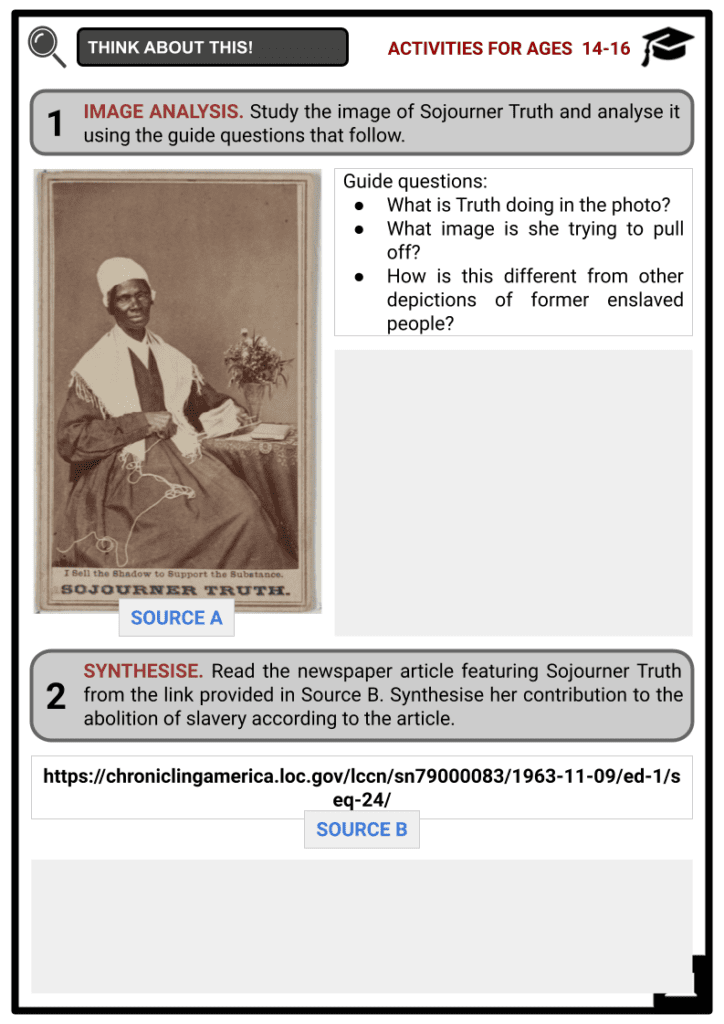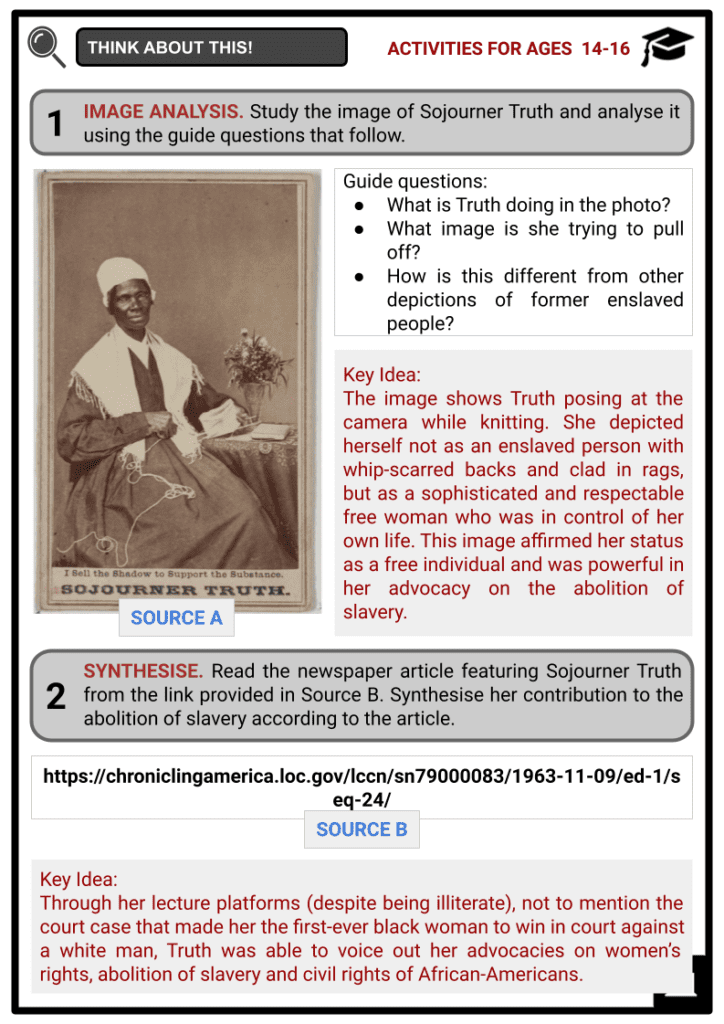Download Sojourner Truth Worksheets
Do you want to save dozens of hours in time? Get your evenings and weekends back? Be able to teach Sojourner Truth to your students?
Our worksheet bundle includes a fact file and printable worksheets and student activities. Perfect for both the classroom and homeschooling!
Table of Contents
Add a header to begin generating the table of contents
Summary
- Sojourner Truth’s early life as an enslaved person
- Truth’s escape from slavery
- Truth’s advocacies and missions in life
- Death and legacy
Key Facts And Information
Let’s know more about Sojourner Truth!
- Sojourner Truth was an American abolitionist, women’s rights activist and evangelist who lived a difficult life as an enslaved person, serving several cruel enslavers until her eventual escape to freedom with her infant daughter in 1826.
- She then became a Christian after gaining freedom and dedicated herself to preaching the gospel and speaking for women’s rights, abolition, and civil rights of African-Americans.
- Two years later, she successfully won the court battle to recover her son who was illegally sold by her previous enslaver, making her the first-ever black woman to win in court against a white man.
- She delivered her most well-known speech “Ain’t I A Woman” at the Ohio Women's Rights Convention in Akron, Ohio. After her death, Truth left behind a legacy of faith and courage to fight for what is right and honourable.
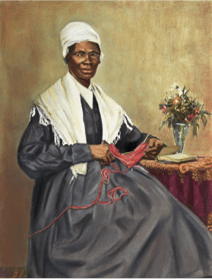
Early Life Of Slavery
- Sojourner Truth, born as Isabella ‘Belle’ Baumfree, was one of James and Elizabeth Baumfree’s children and was born into slavery. In the town of Esopus, New York, an estate known as Swartekill was owned by Colonel Charles Hardenbergh who was the owner of the Baumfree family.
- When Hardenbergh died in 1806, Truth was sold at auction for $100 to John Neely who lived in Ulster County, New York. Her new enslaver was cruel and often beat her a lot. In 1808, she was again sold to another enslaver. For $105, she was sold to Martinus Schryver who lived in Port Ewen, New York. He owned her for about 18 months before she was sold again in 1810 now to John Dumont who lived in West Park, New York. Truth had a difficult relationship with her enslaver’s wife Elizabeth Waring Dumont, as John was a rapist who often took advantage of her.
- In 1815, Truth met and fell in love with an enslaved man named Robert. However, their union was forbidden as Robert’s master did not like the idea of his enslaved people having children with another who was not his own as their children would not be his.
- Despite this, Robert sneaked out to see her again but to their dismay, he was found out by his enslaver who savagely beat him right there and then. The two never met again as Robert died a few years after. This experience traumatised Truth a lot for the rest of her life.
- Eventually, she was able to get married to an older enslaved man named Thomas, albeit by force. Truth bore five children, four of them from her union with Thomas (named Diana, Peter, Elizabeth and Sophia) and one she bore as a result of Dumont’s rape (named simply Dumont).
Escape From Slavery
- In 1799, New York State began to legislate the abolition of slavery. However, the process of freeing the enslaved was not completed until 4 July 1827.
- Before the state emancipation, Dumont promised Truth that he would set her free if she continued to be faithful to him. Unfortunately, he changed his mind which made Truth furious but still managed to continue working to satisfy her sense of obligation to her owner.
- In 1826, Truth together with her infant daughter Sophia escaped. She had to leave her other children behind as they were not yet legally freed under the emancipation order. She later said: "I did not run off, for I thought that wicked, but I walked off, believing that to be all right."
- Until the New York State Emancipation Act was approved, Truth and her daughter were able to find a home in New Paltz under Isaac and Maria Van Wagenen. They offered to buy her services from Dumont for $20 to which he agreed.
- In 1828, she found out that Dumont had illegally sold her five-year-old son Peter to a white man in Alabama. She then took the issue to court with the help of the Van Wagenens. After months of legal proceedings, she got her son back and became the first-ever black woman to win in court against a white man.
- She became a devout Christian during her stay with the Van Wagenens and in 1829 she worked as a housekeeper in New York City for Christian Evangelist Elijah Pierson. She became close friends with one of George Washington’s enslaved people named Mary Simpson.
- In 1832, she met Robert Matthews and worked for him as a housekeeper at the Matthias Kingdom communal colony. After Pierson’s death, both Truth and Matthews were accused of theft and murder, though were later acquitted. In 1842, Truth was never able to see her son Peter again after he took a job on the Zone of Nantucket whaling ship in 1839.
- Truth changed her name and became a Methodist on 1 June 1843, marking a turning point in her life. She particularly chose her name as she recalled the time when she heard the spirit of God calling her to preach the truth. She later left to travel north up through the Connecticut River Valley towards Massachusetts to preach about the abolition of slavery.
- She attended camp meetings of Millerites who followed the teachings of William Miller of New York. Many of them greatly appreciated her preachings and would often crowd in whenever she spoke. Despite this, she later distanced herself from them when their belief of the anticipated appearance of Jesus signalling the end of the world did not come.
- Truth joined the Northampton Association of Education and Industry in 1844 which was an organisation that supported religious tolerance, pacifism and women’s rights. There she met Frederick Douglass, William Lloyd Garrison, and David Ruggles. Despite the organisation’s efforts, it disbanded in 1846 as its members were no longer able to support it.
- As she never learnt to read and write because of her previous position as an enslaved person, Truth started dictating her memoirs to her friend Oliver Gilbert which William Lloyd Garrison privately published in 1850 under the title The Narrative of Sojourner Truth: A Northern Slave. From the sales of her book, she was able to purchase a home in Florence for $300. That same year, Truth spoke in Worcester, Massachusetts, at the first National Women’s Rights Convention.
Women’s Rights: “Ain’t I A Woman?”
- Truth joined abolitionist and speaker George Thompson on a lecture tour in New York State in 1851. At the Ohio Women's Rights Convention in Akron, Ohio, Truth delivered her famous extemporaneous speech on women’s rights titled ‘Ain’t I a Woman?’. Here she demanded equality for women and blacks - an action that was both challenging and difficult around that time, especially since she was both a woman and black herself.

- Though there were contrasting reports and accounts of the contents of her speech, including the reaction of the people, Truth continued to speak in front of hundreds of audiences over the next 10 years.
Missions In Life
- Throughout her life, it became Truth’s mission to use her voice to speak about women’s rights, abolition and civil rights of African-Americans.
- Even with some opposing her, she had numerous supporters, often from prominent and influential people.
- On 3 September 1857, Truth rejoined the Millerites who had formed the Seventh-day Adventist Church. When antislavery movements began earlier in Ohio and Michigan, she joined Michigan abolitionists known as the Progressive Friends.
- Truth contributed to the Union cause during the American Civil War by recruiting black troops for the Union Army. In 1864, she was able to meet then-President Abraham Lincoln.
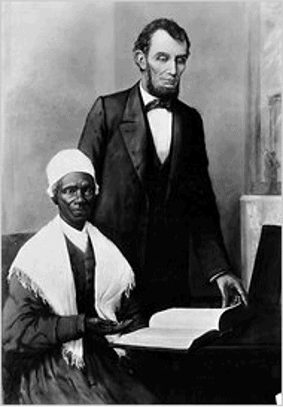
- She also worked to improve the condition of blacks in the US when she was employed by the National Freedman's Relief Association in Washington, D.C. The next year, she rode whites-only streetcars to help end segregation.
- In 1870, she unsuccessfully petitioned to secure land grants from the federal government to former slaves. She also had a meeting with then-President Ulysses Grant in the White House when she was in Washington, D.C. Two years later, she became active in helping Grant’s re-election campaign and even tried to vote during Election Day though was turned down at the polling place.
Death and Legacy
- During her remaining years, Truth was taken care of by her two daughters. She died early on the morning of 26 November 1883 at her home in Battle Creek. Her funeral was held two days later at the Congregational-Presbyterian Church and was attended by nearly one thousand people. She was buried at the Oak Hill Cemetery.
- In Frederick Douglass’ eulogy for her, he said: “Venerable for age, distinguished for insight into human nature, remarkable for independence and courageous self-assertion, devoted to the welfare of her race, she has been for the last forty years an object of respect and admiration to social reformers everywhere.”
- After her death, many memorials, such as memorial plaques, statues, and busts, were erected in honour of her to commemorate her life’s worth of contributions. The first of these was in 1935 at Stone History Tower, Monument Park in Battle Creek, Michigan. Her memorial bust at the Emancipation Hall in the U.S. Capitol Visitors Center made her the first African-American woman to have a statue in the Capitol building.
- She was also inducted into the Michigan Women’s Hall of Fame and National Women’s Hall of Fame in New York, making her one of the very first groups of women to be included. A commemorative postage stamp was also issued by the U.S. Postal Service in her honour.
- In recent years, an image of Truth was announced to appear on the back of a newly designed US $10 bill alongside Susan B. Anthony, Alice Paul, Elizabeth Stanton, and Lucretia Mott.
- She was also included in Smithsonian magazine's list of the ‘100 Most Significant Americans of All Time'.
- After her death, Truth left behind a legacy of faith and courage to fight for what is right and honourable.
Image sources:

